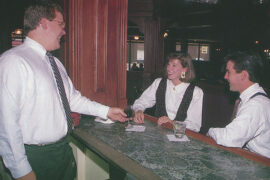West Virginia’s own Pete Dye Golf Club is widely regarded as one of the finest layouts in the world
By Chris Stadelman
HQ 41 | WINTER/SPRING 2001
West Virginia, long known for its coal heritage, now is familiar worldwide for one of its golf courses. Maybe it’s appropriate, then, that the Pete Dye Golf Club is built on a former coal surface mine.
Opened for 18-hole play in 1994, the private course has attracted international attention, with about 350 members from 25 states and five countries, including Japan and Scotland. It boasts a lengthy list of accolades and testimonials, the most noteworthy of which was Golf Week magazine’s 1999 listing as the second best golf course in America built in the Modern Era, those courses built since 1960. That ranked the Pete Dye tract ahead of such revered names as Spyglass Hill, Valhalla, Muirfield Village, Laurel Valley, Bay Hill and the TPC at Sawgrass.
Additionally, the course was selected as a “Hidden Gem” by Golf magazine in 1995 and ranked as one of the Top 100 courses in the United States in 1997.
A ranking from Golf Digest magazine put Pete Dye third in the country among new private courses in 1995 and first in West Virginia from 1997 to 1999. It also selected the layout as one of the Top 100 in America for 1999.

In 1997, Links magazine proclaimed the tract as one of the Top 10 courses of the last decade, remarking, “The Pete Dye Club has more exceptional and memorable golf holes than any other course in the world.”
Pete Dye himself has publicly declined to choose a favorite among his many designs, but the Bridgeport, W.Va. course is the only one in the country to carry the namesake of the world’s preeminent architect.
“It’s like with your children — you’re not supposed to say you have a favorite. There’s no such thing as the greatest golf course in the world. But this one must be included in the ranks of those at the top of the list,” Dye said of his West Virginia gem.
“The historical significance of the land, first as an Indian campground then as the site of a coal mining operation, is combined with the spectacular terrain of the West Virginia hills,” Dye wrote of the course. “There’s nothing more dramatic than this piece of property. You can’t get 18 holes any better than this — take my word for it.”
It is rumored that while playing his much-celebrated Whistling Straits course in Koehler, Wisconsin, which will host the 2004 PGA Championship, Dye was asked by a member of his foursome if this was the best course he had ever designed. Dye reportedly shook his head and said no.
“If you want to see the best, go to West Virginia,” he replied.
From Dye’s peers to the average “Joe,” everyone tends to agree.
Former USGA president Bill Campbell remarked, “Herbert Warren Wind should visit this course to reinforce his opinion that Pete Dye is ‘the Michelangelo of golf course architecture.’”
And in a letter to the club, baseball Hall of Famer Joe DiMaggio noted, “The incredible course and your staff provide the framework for perhaps the most memorable golf experience that I have ever been a part of.”
Dye first saw the property, which had been strip and deep mined since the 1920s, in 1978. He camped at various points around the 300 acres, envisioning particular holes.
Inside the Tour magazine featured the course last year, and noted, “Many of the natural contours and features of the land are incorporated into the design. Old coal cars line the 10th fairway, some bunkers are pulverized coal. Mine portals, exposed strip-mined high walls, a passageway through a deep mine, a coal tipple and creeks and waterfalls utilizing the mine drainage are but a few examples of Pete’s commitment to the land’s heritage. There is no other course like this in the world.”
James J. LaRosa, whose family developed the property, watched the evolution of Dye’s work.
“He walked off the property his first day on it and said he could build one of the greatest inland golf courses in the country,” LaRosa said. “He would say ‘Can’t you see what I can see?’ I’d tell him, ‘No, I can’t.’”
“He’s just a genius. There’s no other way to explain it.”
The course is a typical Dye creation: high risk, high reward. With five sets of tees, it is also accessible to all handicap levels. The front tees play just 5,127 yards, while the championship are set at a challenging 7,166. The “Dye” tees, set in the middle, play 6,218 yards.
Standing on the first tee, players face a picturesque lake, although only the worst push to the right can find trouble there. It’s elsewhere on the course water can wreak havoc.

After surviving a relatively kind 348-yard (from the Dye tees) par 4 opening, the renowned second hole throws golfers into the round in a hurry. A lengthy par 4, it features a hard dogleg left over a canyon. The real decision is how big a chance to take. Taking the ball straight or off to the right greatly increases the chance of the drive safely finding the fairway. But it can leave a second shot of nearly 200 yards into a small green surrounded by bunkers.
Cutting off more of the canyon might leave a short iron into the green. Or it might leave you with an unplayable lie in grass and rocks up to your knees. At 435 yards from the championship tees, it’s truly worthy of its No. 1 handicap designation and Golf magazine’s selection as one of the 500 best golf holes in the world in 1999.
The fourth hole is a long par 3. A kidney-shaped green allows for pin placements directly behind a large lake. A grass collection area awaits on the right side, making accuracy key.
Golfers first encounter a par 5 at the fifth hole. Although the 507 yards might make some think about going for the green in two, one look will discourage all but the most courageous or foolhardy. The fairway is two-tiered, with a hard dogleg right taking up the upper section. Shots pushed to the right will almost certainly end up in the creek that borders the hole.
After a simple par 4 sixth, golfers are treated to one of the course’s famed moments — and it won’t cost them a stroke. Weather permitting, carts have the option of riding through a short portion of a mine portal, complete with roof timbers. It’s an opportunity not to be missed the first time playing the course.
The back nine starts out with another classic use of natural terrain and history. The 396-yard par 4 is a slight dogleg right over a wide creek from an elevated tee. What makes the hole, however, is the scenery. An old coal tipple and slag pile are out of bounds to the left, and natural mine drainage creates a waterfall just off the far right side of the green.
It’s beautiful from afar, but don’t let your ball get too close a look. A shot over the hill on the right side leaves a nearly impossible iron shot back up onto the green.
The par 5 11th hole, at 565 yards from the Dye tees, doesn’t allow anyone shorter than Tiger Woods to attempt an eagle putt. It also has plenty of trouble left and woods off to the right. Once there, however, the green doesn’t offer as many ups, downs, ins and outs as many other Dye creations.
Perhaps the greatest example of that comes on the 17th hole. A short par 4 at 348 yards, the dogleg left gets more interesting around the green.
When the pin is set near the center, as it often is, stopping the golf ball near the hole challenges even the softest hands. Shots that don’t end up in the hole skid back off the green in any direction. Players have been known to be on the green in two but off for their third or fourth shots.
A golfer who recently played the course for the first time arrived at the 17th hole and hit a solid drive down the fairway. As he approached his tee shot, he examined his lie, looked up at the severe contours of the green, and began laughing. “Pete Dye is sick,” he yelled to his playing partners.
Some members initially complained about the degree of difficulty of the 17th green, but Dye reportedly said any changes to the complex putting surface would result in the removal of his name from the course.
It’s hard to believe the course’s signature hole isn’t any of the first 17, but the finishing 18th. The 406-yard par 4 runs above another creek, with a high bank leading up to the road on the right. The two-tiered green is nestled back down the hill to the left. Dramatic and scenic, the Washington Golf Monthly declared the 18th to be “the finest inland finishing hole in the country.”
After concluding the ultimate West Virginia golf experience, it’s time to unwind at the course’s new $5 million, 42,000-square-foot clubhouse. Opened in the spring of 2000, it’s a fitting accompaniment to the stellar course.
“We have two things that set us apart here,” LaRosa said. “One is the golf course and the second is service. We have some wonderful young men and women and management at this facility who understand the type of atmosphere we want to have. That sets us apart.”
The new facility includes a formal dining room, bar and grill area, meeting rooms, pro shop and foyer with a portrait of Pete Dye. Amenities in the locker rooms include 285 lockers made of West Virginia black walnut, copper bowls set in marble sinks and overhead showers as well as sauna and steam rooms.
“This enhances the golf course. It’s an amenity that allows people to make better use of the golf course,” LaRosa said. “It should make a difference in how people look at the club.”
When LaRosa and his father, James D. LaRosa, wanted a world-class course they picked a world-class architect to design it.
“I think we saw an opportunity here,” James J. LaRosa said. “We saw an opportunity to elevate the status of Northcentral West Virginia by building a world-class golf course based on Pete Dye’s vision. The real story here is about the land, Pete Dye and the commitment to funding and building his dream.”
Pete Dye Golf Club is a national golf club, meaning private memberships for local residents are limited. The total membership goal is 480, with about three-quarters of those already filled.
As the club continues to evolve, LaRosa said he would like to see more members from Southern West Virginia, the Kanawha Valley and the Tri-State area. Many people have trouble thinking about driving north to play golf, he said.
“The club has evolved into an executive golf retreat,” he said. “We want to have controlled growth but still continue the privacy and intimacy.” While people can talk about the course being in Northcentral West Virginia and out of the way, the counter argument is that it’s the private retreat for which people are looking.
“Obviously I would like to see West Virginia business people participate in this environment. As we move closer to our membership goals, we would like to have more of West Virginia’s people involved in that.”





